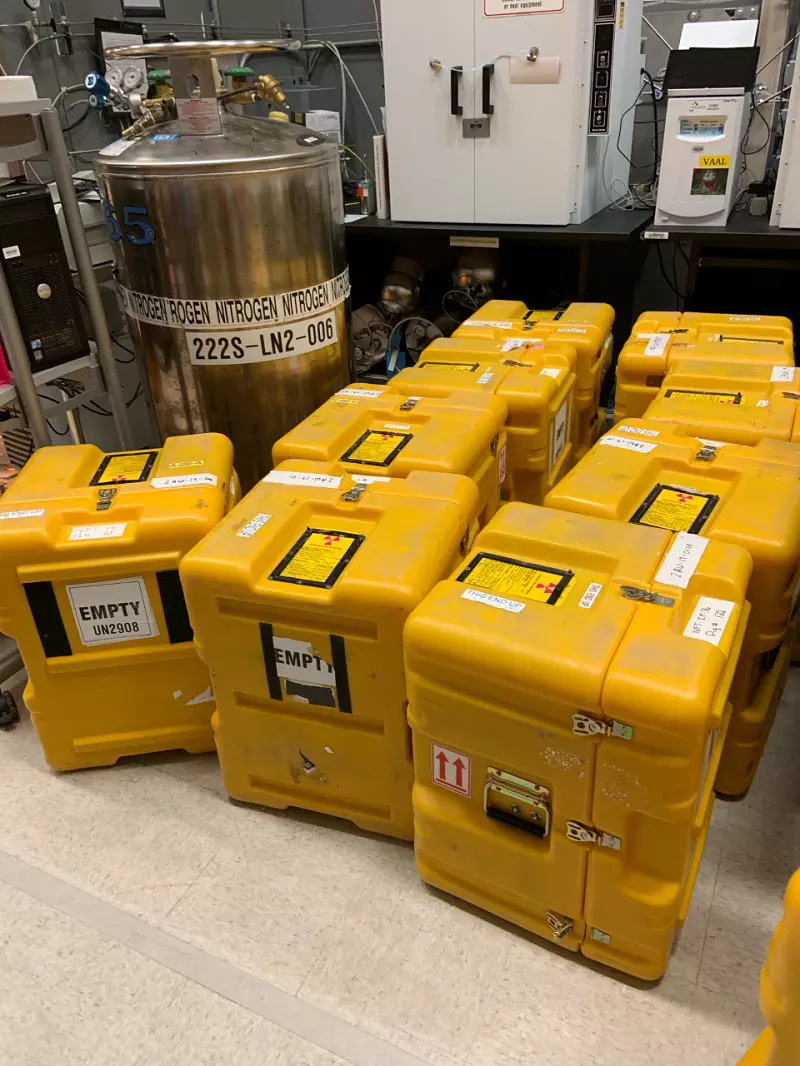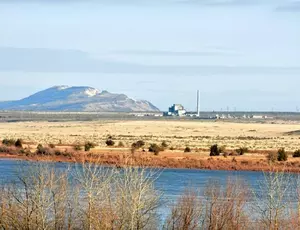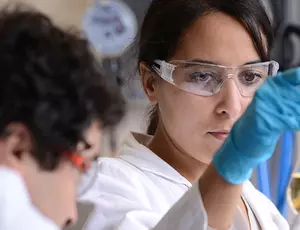Established in 1943, the Hanford Site's original mission was to produce plutonium for national defense. Operations to make the raw materials for nuclear weapons continued until the late 1980s. The waste remaining from those operations is a potential threat to human health and the environment including the Columbia River. In 1989, Hanford's mission shifted from production of weapons material to waste management and environmental cleanup. About 56 million gallons of waste, left over from the plutonium production period, are stored in 177 underground tanks at Hanford, each ranging in capacity from 55,000 gallons to more than 1 million gallons.
DOE's Office of River Protection (ORP) is responsible for the safe storage of the tank farm waste, future treatment of the waste, and transportation of the immobilized waste to approved facilities. The 222-S Lab is a critical support facility for ORP’s mission.
The lab plays many roles, which include testing of waste compatibility and physical characteristics to support tank-to-tank waste transfers, performing corrosion rate studies and chemical testing to support tank corrosion inhibition, and providing input to the engineering specifications for each of the 242-A Evaporator campaigns. The lab also studies the physical and chemical characteristics of waste necessary to enable waste retrievals, provides data to support tank closure requirements, and supports the Vadose Zone Program. In the near future, the 222-S Lab will also analyze tank waste samples from the Tank Side Cesium Removal system – to ensure that the waste meets all of the Waste Acceptance Criteria.
In addition to ORP, the lab also supports other Hanford contractors and projects such as the Spent Nuclear Fuel Project and the Central Plateau Closure Project.
DOE awarded VNSFS 98 percent of its annual award fee for operations at the lab in 2018, citing the company's significant improvements to laboratory operations "by initiating new project management approaches, identifying and resolving quality affecting issues, improving the analytical instrument maintenance program, expanding the use of automated bar code reading, and identifying improvements to sample analysis and waste handling processes."
Communication and safety are the key
The 222-S Laboratory is a 70,000 square foot full-service analytical facility that handles highly radioactive samples for purposes of organic, inorganic, and radio-chemistry analyses. It contains 11 hot cells, which give the lab the capability to remotely handle highly radioactive samples of tank waste while minimizing radiation dose to workers. The Laboratory complex contains more than 100 pieces of analytical equipment, 156 fume hoods, and 46 manipulators.
Around 10,000 waste samples are received annually (~50 each working day), and approximately 25,000 analyses are performed on these samples (~120 each day) - a critical component of the DOE's cleanup mission at Hanford.
Workers at 222-S Laboratory are kept safe from harmful vapor exposures when working with waste samples by strictly adhering to administrative and technical procedures.
Each day starts with a 6:30 a.m. meeting of the VNSFS leadership team, where project updates are provided, equipment maintenance and repairs are announced, and team member safety is stressed. Department managers then share highlights of those daily briefing reports with their individual teams in meetings that immediately follow throughout the lab complex, after which everyone heads out to complete the day's assignments. "222-S, Where Safety is Not an Experiment” appears at the top of the Daily Operating Instructions distributed at the morning meetings - a constant reminder that safety is paramount in everything done at the lab.

The lab's Environmental, Safety & Health (ES&H) Program Lead coordinates and leads communications about safety with all team members. She accomplishes this important job in a variety of ways including: weekly Safety Start sheets with lab (and home) safety information and tips; monthly employee-led Zero Accident Council meetings, a forum to discuss safety concerns and initiatives; a program that rewards employee for safe actions; and quarterly safety campaigns or contests. She also heads up the lab's Voluntary Protection Program (VPP) team, with its regular reports and assessments.
Such frequent and open communication between management and employees was one of the main reasons cited by DOE when it recertified the 222-S Lab as a VPP Star Site in late 2018. The lab's safety program "includes a strong employee involvement element," DOE's Office of Environment, Health, Safety and Security wrote in its onsite review report. "Managers empower employees to participate in safety and health programs by collaborating with employees and implementing initiatives that maintain open lines of communication and promote a clear understanding of safety and health responsibilities.
A typical day
All the sampling work at the 222-S lab begins with one document - the Tank Sampling and Analysis Plan (TSAP). Our experts look at the history of the tank, the end goal, how many samples and from where in the tank, and what we are testing for. The TSAP gets input from several agencies before a final version is assigned to a VNSFS project coordinator. The extremely detailed plans include everything to be done to the tank waste sample in the hot cell.
Each project coordinator works closely with a chemist to complete the TSAP. Before any samples can be analyzed, they must first be prepared to the exact requirements set out in the TSAP. The tank waste liquid arrives in the Hot Cells area of the lab in small metal canisters loaded inside larger, yellow chests.
Typically, our experts use the remote manipulators to unscrew bottle lids, pour samples into tiny beakers and move containers around in the cell. Using controls on the other side of a glass window, they expertly move the robotic arm/claw as if it were an extension of their own body, breaking down a tank sample into the exact measurements laid out in the TSAP, before placing each single sample into a shielded single sample carrier and pushing it out to hot cell door to a waiting chemist in full protective gear. After the samples leave the hot cells, chemists and chemical technologists perform all the tests (radiochemistry, organic and inorganic) outlined in the TSAP.
The purpose of all this sampling and analysis at the 222-S Lab is to help DOE determine exactly what waste is in the underground Hanford tanks, what the waste is doing to the tanks, and how long the tanks will last. DOE plans to eventually pump all the tank farm waste to a vitrification plant on site. The vitrified waste will be put into steel canisters and safely dispositioned.The 222-S Laboratory is expected to operate until at least 2030 in support of the Hanford cleanup mission. Until then, goal of the lab staff is to make every day a good, safe day.




